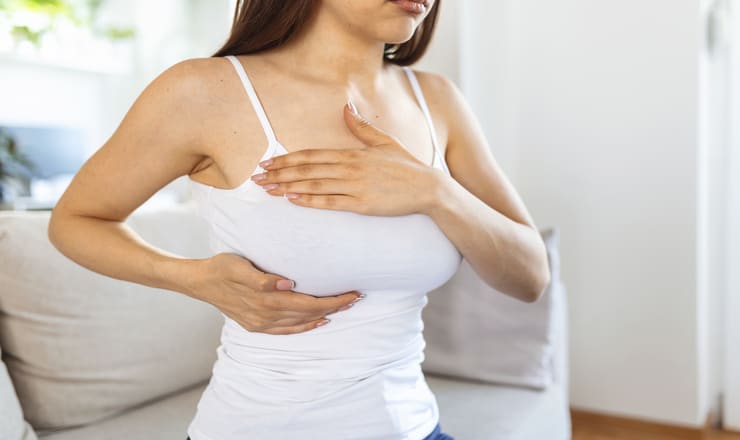What Are Breast Cancer Lumps Like? Here's the Explanation
Breast cancer is a serious health concern that affects millions of women around the world. One of the most common symptoms of breast cancer is the presence of lumps in the breast tissue. These lumps can vary in size, shape, and texture, and may or may not be cancerous.
So, what are breast cancer lumps like? Breast cancer lumps are typically hard, immovable masses that can be felt in the breast tissue. They may feel like a small pebble or marble under the skin, and are usually painless. However, it's important to note that not all breast lumps are cancerous. In fact, the majority of breast lumps are benign, or non-cancerous.
What are the characteristics of non-cancerous breast lumps? Non-cancerous breast lumps can also vary in size and texture, but they tend to be softer and more movable than cancerous lumps. They may feel like a fluid-filled sac or a rubbery mass, and are often accompanied by pain or tenderness. Non-cancerous breast lumps are usually caused by hormonal changes, cysts, or fibroadenomas, which are benign tumors made up of glandular and connective tissue.
It's important to see a healthcare provider if you notice any changes in your breast tissue, including the presence of lumps. Your healthcare provider can perform a clinical breast exam and order diagnostic tests, such as mammograms or ultrasounds, to determine the cause of the lump. In some cases, a biopsy may be necessary to confirm whether the lump is cancerous or non-cancerous.
If a breast lump is found to be cancerous, further testing will be done to determine the stage of the cancer and develop a treatment plan. Treatment options for breast cancer may include surgery, radiation therapy, chemotherapy, hormone therapy, or targeted therapy. The prognosis for breast cancer varies depending on the stage of the cancer, but early detection and treatment can significantly improve outcomes.
In addition to regular screenings and self-exams, there are steps you can take to reduce your risk of developing breast cancer. Maintaining a healthy lifestyle, including eating a balanced diet, exercising regularly, limiting alcohol consumption, and avoiding tobacco products, can help lower your risk. It's also important to know your family history of breast cancer and discuss any concerns with your healthcare provider.
In conclusion, breast cancer lumps are typically hard, immovable masses that can be felt in the breast tissue. However, not all breast lumps are cancerous, and many are benign. Non-cancerous breast lumps are usually softer and more movable than cancerous lumps, and may be accompanied by pain or tenderness. If you notice any changes in your breast tissue, it's important to see a healthcare provider for evaluation and testing. Early detection and treatment are key to improving outcomes for breast cancer patients. Stay informed, stay vigilant, and take care of your breast health.
So, what are breast cancer lumps like? Breast cancer lumps are typically hard, immovable masses that can be felt in the breast tissue. They may feel like a small pebble or marble under the skin, and are usually painless. However, it's important to note that not all breast lumps are cancerous. In fact, the majority of breast lumps are benign, or non-cancerous.
What are the characteristics of non-cancerous breast lumps? Non-cancerous breast lumps can also vary in size and texture, but they tend to be softer and more movable than cancerous lumps. They may feel like a fluid-filled sac or a rubbery mass, and are often accompanied by pain or tenderness. Non-cancerous breast lumps are usually caused by hormonal changes, cysts, or fibroadenomas, which are benign tumors made up of glandular and connective tissue.
It's important to see a healthcare provider if you notice any changes in your breast tissue, including the presence of lumps. Your healthcare provider can perform a clinical breast exam and order diagnostic tests, such as mammograms or ultrasounds, to determine the cause of the lump. In some cases, a biopsy may be necessary to confirm whether the lump is cancerous or non-cancerous.
If a breast lump is found to be cancerous, further testing will be done to determine the stage of the cancer and develop a treatment plan. Treatment options for breast cancer may include surgery, radiation therapy, chemotherapy, hormone therapy, or targeted therapy. The prognosis for breast cancer varies depending on the stage of the cancer, but early detection and treatment can significantly improve outcomes.
In addition to regular screenings and self-exams, there are steps you can take to reduce your risk of developing breast cancer. Maintaining a healthy lifestyle, including eating a balanced diet, exercising regularly, limiting alcohol consumption, and avoiding tobacco products, can help lower your risk. It's also important to know your family history of breast cancer and discuss any concerns with your healthcare provider.
In conclusion, breast cancer lumps are typically hard, immovable masses that can be felt in the breast tissue. However, not all breast lumps are cancerous, and many are benign. Non-cancerous breast lumps are usually softer and more movable than cancerous lumps, and may be accompanied by pain or tenderness. If you notice any changes in your breast tissue, it's important to see a healthcare provider for evaluation and testing. Early detection and treatment are key to improving outcomes for breast cancer patients. Stay informed, stay vigilant, and take care of your breast health.
